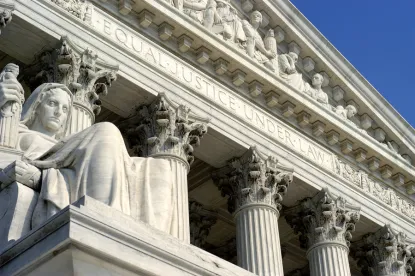On June 29, 2015, the Supreme Court of the United States (SCOTUS) remanded EPA’s mercury and toxics air standards rule (MATS Rule) that had established hazardous air pollutant (HAP) emission limitations for utility boilers. SCOTUS accepted the appeal on one narrow issue, “[w]hether the Environmental Protection Agency unreasonably refused to consider costs in determining whether it is appropriate to regulate hazardous air pollutants emitted by electric utilities.” Although this ruling is a setback for EPA, the impact on Wisconsin utility boilers is likely minimal. The federal MATS Rule remains in effect (for the time being) and EPA has signaled its intent to expeditiously address the Court’s concerns. However, the decision does not resolve all of the legal uncertainties surrounding the MATS Rule and adds a twist to future challenges to EPA’s greenhouse gas (GHG) rules for the utility sector. These challenges are discussed below.
Background
EPA’s efforts to regulate HAP emissions from electric utility boilers has a storied past. It begins with the passage of the Clean Air Act Amendments of 1990 whereby electric utilities became the most regulated air emission sources in the country. Congress anticipated that that these utility regulations might overlap and produce co-benefits whereby the pollution control technologies installed to control criteria pollutants (SO2, PM, NOx, etc.) would simultaneously reduce utility HAP emissions. Congress sought to avoid creating unnecessary regulatory burdens on utilities which would compound the electric rate increases that would be driven by Clean Air Act compliance.
In an effort to mitigate these concerns, Congress directed EPA to refrain from directly regulating electric utility HAP emissions until completing a two-step process. First, EPA was to conduct a study of the hazards to public health reasonably anticipated to occur from utility HAP emissions that were still being emitted after imposition of all other Clean Air Act requirements. Second, EPA was to determine whether additional regulation of these utility HAP emissions would be “appropriate and necessary” after considering the results of the study. This two-part test was intended to avoid installation of unnecessary emission control equipment and to ensure that any decision to directly regulate HAP emissions from electric utility boilers accounted for the collateral pollution control impacts of other Clean Air Act programs. Following this two part directive, EPA issued a series of conflicting regulatory findings as to whether it is “appropriate and necessary” to regulate electric utility HAPs.
In 2000, EPA determined that it would be “appropriate and necessary” to regulate HAPs from utilities.[1] EPA based this finding on the results of a study completed in 1998 which concluded that coal and oil fired electric utility boilers were the largest domestic source of mercury emissions.
In 2005, EPA reached the opposite conclusion finding that it is neither “appropriate nor necessary” to regulate HAPs from electric utilities.[2] At that time, EPA planned to promulgate a new source performance standard for the utility industry which would result in reductions of mercury emissions, therefore making it inappropriate and unnecessary to regulate those emissions under EPA’s HAP authority. In 2008, the U.S. Court of Appeals for the D.C. Circuit vacated EPA’s 2005 decision.[3]
In 2012, EPA issued its most recent determination that again found that it is “appropriate and necessary” to regulate HAP emissions from electric utilities. Notably, EPA interpreted the phrase “appropriate” to preclude any consideration of cost.[4] Nonetheless, when EPA issued the MATS Rule itself, it estimated the compliance costs to be $9.6 billion. The benefits of mercury reduction were estimated in the range of $4 million to $6 million, with collateral benefits of particulate matter and sulfur dioxide reductions in the range of $37-90 billion. Despite the “cost to benefit” ratio of controlling mercury being skewed against further regulation, EPA determined that it had no choice but to regulate utilities under Section 112 because costs could not be considered in the decision-making process.
Litigation ensued within the lower courts. These decisions were appealed to the SCOTUS which agreed to consider whether EPA must factor in costs in determining whether it is appropriate and necessary to regulate utility HAP emissions. The Supreme Court held that EPA is obligated to consider costs, and, therefore, EPA’s 2012 decision to regulate utility HAP emissions under Section 112 was illegal.
As of today, the MATS Rule remains in effect. On remand, the D.C. Circuit Court will have discretion as to whether to vacate the MATS Rule while EPA completes the necessary cost analysis. However, the D.C. Circuit might chose to leave the rule in place, especially since most utility boilers have already achieved compliance with the MATS Rule by installing controls, switching to other fuels or shutting down.
Effect on Wisconsin Utilities
The effect on Wisconsin utilities is likely minimal. In 2008, WDNR promulgated state rules (NR 446) defining mercury emission limitations for coal fired utility boilers located in Wisconsin. Wisconsin utility boilers are exempt from these state mercury rules so long as the MATS Rule remains in effect. If the federal rules are ever withdrawn or deemed invalid, Wisconsin utilities would still face mercury emission reduction obligations under these state rules.
In reliance on these state and federal rules, Wisconsin utilities have already obtained permission from the Public Service Commission of Wisconsin to install controls to meet mercury limitations. Those controls have either been installed or are in the process of being installed on Wisconsin utility boilers.
Residual Issues Remain
Although the SCOTUS decision focuses on EPA’s authority to impose HAP emission limitations on utilities, the federal MATS Rule emission limitations themselves remain subject to other challenges. In this regard, EPA established some mercury limitations relying upon a statistical tool known as the Upper Prediction Limit (UPL) Method. The UPL Method allows EPA to consider the “real world” operating limitations of a boiler when estimating the emission performance that can be achieved by certain pollution control technology. When EPA established the mercury emission limitations for new and reconstructed utility boilers, it used the UPL Method to relax the emission limitation that would otherwise apply to these units.
The environmental community has challenged use of the UPL Method in the context of EPA establishing HAP emission limits for sewage sludge incinerators. The D.C. Circuit remanded the sewer sludge rule to EPA with directions to further explain and justify use of the UPL Method. Environmentalists have challenged several other EPA HAP rules which also rely on the UPL Method. These lawsuits remain pending in the D.C. Circuit and will be decided later this year. An adverse decision on EPA’s use of the UPL Method could result in renewed challenges to certain limits in the MATS Rule.
Aside from the uncertainty surrounding the UPL Method, there is pending litigation over the stringency the MATS Rule. The challenge was filed on June 22, 2015 and focuses on EPA’s rejection of a petition for reconsideration that requested relaxation of the HCL limit and changes to certain definitions in the final rule. None of these issues were resolved by the SCOTUS decision.
Implications for the Clean Power Plan
As many readers know, EPA has proposed a controversial regulatory program to limit GHG emissions from the utility sector (a/k/a the Clean Power Plan). EPA proposes to issue the Clean Power Plan under Section 111 of the Clean Air Act which authorizes the creation of New Source Performance Standards (NSPS) for industry sectors. Yet, there are credible arguments that the Clean Air Act precludes EPA from establishing an NSPS for any source category that is already regulated under Section 112 of the CAA. EPA arguably will violate this restriction if it continues to pursue regulating utility HAP emissions under Section 112 and then attempts to regulate utility GHG emissions under Section 111. Murray Energy has already filed a lawsuit advancing this argument which was dismissed as being premature. Critics of the Clean Power Plan may argue to leave the federal MATS Rule in place while EPA performs a cost analysis, thereby preserving the argument that EPA is impermissibly double regulating utilities under Section 111 and 112 of the Clean Air Act.
[1] 65 Fed Reg. 79,825 (December 20, 2000).
[2] 70 Fed Reg. 15, 994 (March 29, 2005).
[3] New Jersey vs. EPA, 517 Fed. 3rd 574 (D.C. Circuit 2008).
[4] 77 Fed. Reg. 9,304 (February 16, 2012).




 />i
/>i

